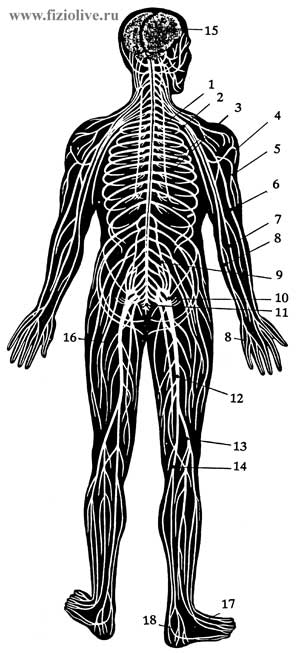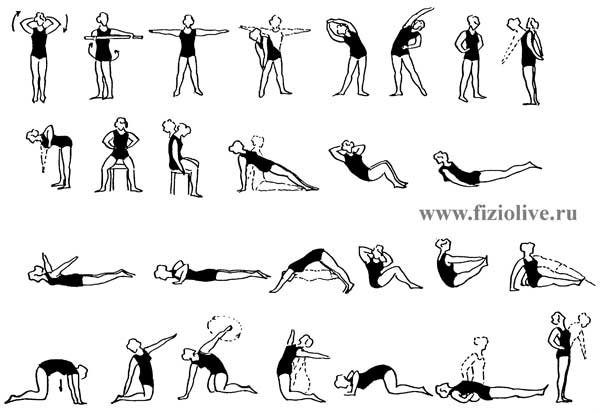
| HOME | MENU | DOCS | SEARCH |
Translations of articles in the English language
is in automatic mode, the original version
of the article in Russian - here
The content of the article "physical therapy for injuries and diseases of the Central and peripheral nervous system":
*Initial position - I. p.
The nervous system controls the activities of the various organs and systems that constitute the whole organism, carries out its relationship with the external environment, and coordinates the processes occurring in the body depending on the state of the external and internal environment. It carries out coordination of blood circulation, lymph flow, metabolic processes that, in turn, affect the condition and functioning of the nervous system.
The human nervous system is conventionally divided into Central and peripheral (see Fig. Central and peripheral nervous system). All organs and tissues of the nerve fibres forming sensory and motor nerve endings. The first, or receptors, provide the perception of stimuli from the external or internal environment and convert the energy of stimuli (mechanical, chemical, thermal, light, sound, etc.) in the process of excitation transmitted to the Central nervous system. Motor nerves send arousal from nerve fibers to innervated body.
Central and peripheral nervous system

1 - phrenic nerve; 2 - brachial plexus; 3 - intercostal nerves; 4 - axillary nerve; 5 - musculo-cutaneous nerve; 6 - the radial nerve; 7 - median nerve; 8 - ulnar nerve; 9 - lumbar plexus; 10 - sacral plexus; 11 - pudendal and the coccygeal plexus; 12 - sciatic nerve; 13 - peroneal nerve; 14 - tibial nerve; 15 - brain; 16 - external cutaneous nerve of the thigh; 17 - lateral dorsal cutaneous nerve; 18 - tibial nerve.
The disease is mainly due to congenital or acquired changes in the spine and its ligamentous apparatus, etc. Pain, which periodically intensifies during exacerbation of the disease, localized in the lumbosacral region, usually on one side, irradiiruet in the buttock, rear thighs, outer surface of the tibia. Sometimes there is numbness and violation of skin sensitivity.
When sciatica shows LH (see Fig. Approximate complex LH in the lumbar sacral radiculitis), walking, Cycling, rowing, swimming, sauna (bath), stretching exercises, massage with heated massage oil, etc.
Approximate complex LH in sciatica

Sedentary lifestyle of modern man has given rise to such common diseases as osteochondrosis, which in our country suffers from a few tens of millions of people. As a result of violation of local blood circulation in the vertebrae and the intervertebral discs undergoes various degenerative changes. Elastic nucleus pulposus of these discs, which plays the role of absorber shrinks and flattens, and its sheath (the fibrous ring), connecting two adjacent vertebrae, the dimensions of the vertebrae (similar to cement mortar between two bricks). A gradual process of degeneration in the fibrous ring is completed by formation of cracks, gaps through which the deformed nucleus pulposus may fall, - this forms the herniated disc. Going to squeeze it near nerves and blood vessels and cause prolonged and excruciating pain (lower back and lower extremities that is commonly referred to as sciatica or sciatica; neck and arm, depending on localization of hernia).
But even before the loss of deformed nuclei both adjacent vertebra due to loss of elasticity of cartilage strips have been exposed to constant friction. This leads to their coarsening, the formation of bone growths on the edges of the vertebrae, which also injure adjacent nerves and cause pain.
For the treatment of osteoarthritis apply a variety of methods and tools, including surgery. But in all cases necessarily is appointed medical gymnastics. Below are two sets of physical exercises, one of which is indoors and the other in the pool.
Note: I. p. - initial position; TM - the pace is slower; TA -the average pace.
Approximate complex LH in spinal osteochondrosis

1. I. p. - standing, hands behind his head. Take turns lifting the shoulders up. 4-6 times. TM. Breathing evenly.
2. I. p. - standing, hands forward. Turns left and right. 5-7 times. TC.
3. I. p. - standing, hands at sides. Then hands on waist and a slight tilt of the torso and head down. 4-6 times TC.
4. I. p. - the same. The slope of the right thigh, exhale. I. p. - breath. The same to the other foot. 5-7 times.
5. I. p. - standing, hands "in lock". The slopes of the left and right. By 4-6 times. TM.
6. I. p. - standing, hands on his belt. In turn tilts left and right. One hand goes up, the other on the belt. 6-8 times. TC.
7. I. p. - the same. Shoulders forward, head lowered, exhale; raise your shoulders, straighten head - inhale. 6-8 times. TM.
8. I. p. - standing, hands behind "in lock". SAG, making a slight inclination forward, arms relaxed, exhale. 4-6 times. TC.
9. I. p. - standing, a trunk in the slope, hands down. Bend the hands to the shoulders, shoulder blades connect. 4-8 times. TC.
10. I. p. - standing, hands on his belt. Make a small tilt forward, shoulders and elbows forward, head lowered, exhale. To bend, straighten head - inhale. 5-7 times. TM.
11. Upright - to sit up. 8-10 times. TC.
12. I. p. - sitting, legs bent at the knees, hands behind your head. Turns left and right. By 6-8 times. TC.
13. I. p. - lying on his stomach. To bend, the blade coupling; to return to I. p. 8-10 times. TM.
14. I. p. - lying, arms at sides. SAG - arms dissolve in the hand. 6-8 times. TC.
15. I. p. - lying, if he puts his hands - to bend; to return to I. p. 8-10 times. TC.
16. I. p. - sitting, hands behind his head. The left-right, left elbow to get your left knee, right right. By 6-8 times. TC.
17. I. p. - sitting. Lift your feet and touch hands sock feet. 4-6 times. TC.
18. I. p. - sitting. To stand up straight with a left turn. The same in the other direction. 4-6 times. TC.
19. I. p. - on your knees. SAG. 6-8 times. TC.
20. I. p. - on your knees. Turns left and right, to touch the hand of the heel. By 4-6 times. TC.
21. I. p. - standing on their heels. Straighten up - arms at sides; return to I. p. 4-6 times. TC.
22. Turns to the side and rotate the left hand. The same is right.
23. Podizanje. 4-8 times. TC. Breath not to detain.
24. Get up - go to bed. 5-7 times. TM.
25. I. p. - standing, hands on his belt. Hands down-tilt the head to lower. 5-7 times. TC.
When performing exercises in water on the human body is exposed to thermal, mechanical and chemical factors. Warm water has a soothing action, facilitates implementation of exercises.
The prostate is therapeutic or prophylactic. If water exercises are performed in combination with traction, the water temperature - 35-37В°C During exercise in the pool water temperature usually is 27.5-32В°C.
Widely used in water exercises with osteochondrosis, arthritis, radiculitis, etc. However, in the acute stage of injury or disease of gymnastic exercises in water are contraindicated.
Loads must be optimal in regard to age, sex, and physical preparedness. Cannot be included in the first classes of complex exercises with high intensity, high repeatability and range of motion in the joints.
Below is an approximate set of exercises performed in water (pool) in spinal osteochondrosis and deforming arthrosis (arthritis).
Exercises are performed at a wall (the rim) basin:
1. The sequential splaying of the left (right) foot to the side. 5-10 times for each leg.
2. Alternate the lead foot forward. By 5-10 times.
3. The rotation of the leg in the hip joint. By 6-10 times.
4. The forward bend - exhale, stand up, inhale. 5-7 times.
5. Hands forward "in lock" - torso twists to the left (right). By 5-10 times.
6. Hands forward (compress brushes in a fist), hands to shoulders, to try to connect the shoulder blades in the back. 5-10 times.
7. Arms to the side. Torso twists left and right. By 5-10 times.
8. I. p. - lying on a rubber pad to support the rubber cushion, legs extended. Alternately lift your feet up. 5-10 times each.
9. I. p. - the same. Lifting both legs up. 6-10 times.
10. I. p. - holding hands on the ledge. Exercise "swimming breaststroke". 20-30 C.
11. I. p. - lying on his back, holding his hands over the rail. Alternately lift your feet up. By 5-10 times.
12. I. p. - standing at the side. Exercises with rubber bandage (need to fix). Perform exercises for the arms, bending the torso, etc.
13. The walk in squat in the pool (a small place). 20-30 C.
14. I. p. - standing, hands on his belt. Trunk bending to the right and to the left. By 5-10 times.
15. I. p. - standing, hands behind his head. Turning the torso to the side. By 5-10 times.
16. I. p. - the same. Hands forward and lifting straight leg to the hands. By 5-10 times.
17. Lie on an inclined Board. Holding hands on the side edge of the Board, raise in turn straight leg (left and right) up. 5-15 times.
18. I. p. - the same. Lifting both legs up. 5-10 times.
V.I. Dubrovsky,
Academician of the Russian Academy of Natural Sciences,
IANPO and the New York Academy of Sciences,
Doctor of Medical Sciences, Professor,
A.V. Dubrovskaya, pediatrician
It is available for the original version
of the article in Russian
<< Previous: Exercise therapy for injuries and diseases
We recommend that you look at the popular sections of the site myvaleology.com: MENU with a description of the sections | |||
| SOCIAL | DONATION | MY DIET | MY SPORT |

|
Release all4e8 |
||
Copyright © VZOJ 2023. All rights reserved. When reprinting or quoting myvaleology.com materials please put a link to the site myvaleology.com :
<a href="https://myvaleology.com">Healthy lifestyle</a>